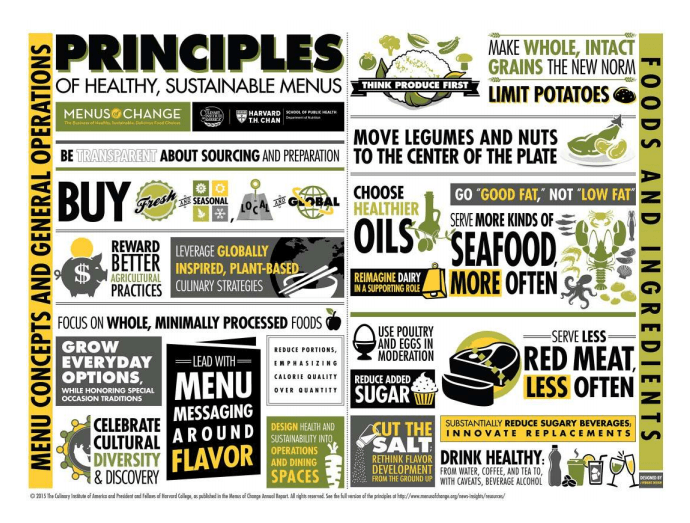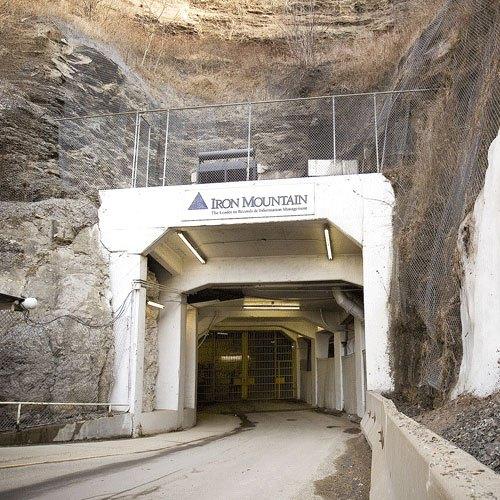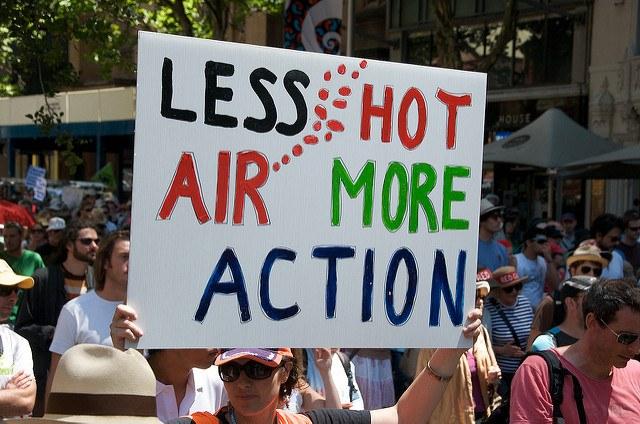Food 2.0: More Plants, Less Meat


By Kristie Middleton
The obesity epidemic. Chronic disease. The skyrocketing global population. These things individually present unique and urgent challenges. Together, they create a crisis. While humane, environmental and hunger-relief organizations are seeking ways to feed the ballooning population that is expected to reach 9 billion by 2050, health organizations are scrambling to curb obesity and stymie heart disease. An abundance of research supports the notion that one of the easiest and most powerful interventions to address all of these challenges is a plant-based diet.
Because of these and other reasons, people are more frequently choosing healthy, meat-free food options that are better for us, the environment and the animals raised for our food system. There’s a correlating shift by chefs and restaurateurs to move vegetables to the center of the plate in addition to a wave of new food companies that aim to disrupt animal agribusiness through more sustainable plant-based food options.
Menus of Change is an annual conference assembled by the Culinary Institute of America and the Harvard School of Public Health, and is attended by chefs, public health experts and representatives from some of the world’s biggest food companies. The conference emphasizes the importance of reducing animal products and getting more plant-based foods on Americans’ plates. Backed by Dr. Walter Willet, chairman of Harvard’s Nutrition Department, the conference’s Principles of Healthy, Sustainable Menus recommend moving nuts and legumes to the center of the plate and leveraging globally-inspired plant-based recipes and meal offerings to create healthy, sustainable menus.
Chefs and foodservice providers are responding to this rally cry with a host of novel approaches. University of California, Berkeley students enjoy plant-forward meals at Brown’s - A California Café. At this campus favorite, guests can choose the less-meat “Flipped Plate,” with seasonal plant choices like brown rice, caramelized onion and parsley pilaf, roasted broccoli with cumin and house-made hummus with paprika pita chips and an entrée — including plant-based options like root vegetable gratin and grilled portabella mushroom caps, or a plant-strong sampler plate featuring all-vegetable options as the stars of the dish.
Compass Group, the world’s largest foodservice company, has created an all-vegan dining concept called ‘Rooted ... in Good Taste,’ which emphasizes wholesome fare, including comfort foods and international flavors that appeal to all diners. “Customers are selecting more vegetarian-style entrées and snacks than ever before, and Compass Group is making it easy for guests to find vegetable-based options,” writes Food Management.
Others are cutting meat with mushrooms as a way to harness the fungi’s savory umami flavor and moisture, while reducing the intake of saturated fat and cholesterol as promoted by the Mushroom Council’s “Blendability” campaign.
Consumers are latching on and the meat industry is taking note. Meat industry trade journal Meatingplace wrote: “The Protein and the Plate research project … showed 70 percent of meat eaters substituting a non-meat protein in a meal at least once a week and 22 percent saying they are doing it more often than a year ago.” The journal pointed to the increased interest of investors in plant-based food options and large packaged food companies acquiring and developing meat-free products to meet the growing demand, including General Mills, Kellogg, Kraft and Pinnacle Foods.
Other companies like Hampton Creek, Impossible Foods and Beyond Meat are re-creating traditional foods without the animal ingredients for products that are better for our health, the planet and animal welfare.
Perhaps the easiest — and tastiest — way to improve our diet is by practicing the Three Rs: "reducing" or "replacing" consumption of animal products, and "refining" our diets by choosing products from sources using higher animal welfare standards.
These strategies represent unique approaches to solving some of the world’s most severe problems one bite at a time. The food industry is wise to latch onto these approaches for a brighter future — a Food 2.0.
Kristie Middleton is the senior director of food policy for The Humane Society of the United States.
How to Buy a Wind Farm: Lessons in Corporate Green Power


By Kevin Hagen
Major corporations across the country are recognizing the benefits of wind and solar power to cut greenhouse gas (GHG) emissions, stabilize energy costs, reduce operating expenses and minimize their dependence on fossil fuels. These trends are easy to read about, but actually doing it can be challenging.
Because data backup firm Iron Mountain is a pretty typical company, we hope it’s helpful to share some of our steps and missteps as we’ve gone from testing the waters, to becoming among the top 25 corporate purchasers of renewable energy over the past two years.
Who are we, and why are we doing this?
We are the leaders in storage and protection of critical assets from business documents and data to fine art. We’re primarily a business-to-business (B2B) company, but our trucks are seen in many cities and our iconic document storage boxes and secure shred bins are seen in offices everywhere because we serve some 94 percent of the Fortune 1000. With over $3 billion in sales, we’re an S&P 500 company with 1,100 facilities comprising over 70 million square feet in 41 countries, and we have over 20,000 employees.
Our relationships with our customers and our communities are measured in decades and are built on trust. We realize that to earn and keep trust requires more than just delivering solid service. It requires us to think about all aspects of how we run our business from how we protect our customer’s assets, to how we treat our employees to how we run our operations. Incorporating environmental and social responsibility into everything we do is what stakeholders expect from a brand they trust.
Missteps
Probably my most uncomfortable day at Iron Mountain was telling the CEO’s chief of staff that we missed our first GHG goal. I don’t recommend missing your first goal, but it was a great way to confirm that the CEO was committed to transparent reporting. In fact, he addressed it in his introduction to our corporate responsibility report and admitted that although missing a target was hard, without that first goal, we probably would not have learned as much.
That experience greatly impacted our methodology for rigorous metrics. When our 2015 results are published, we report progress because of what we learned -- especially about energy.
Finding our way
Like many corporations our size, energy management was one of many priorities for our operations team. GHG metrics helped us see that small impacts of electricity in many places added up to a surprising 50 percent of our global footprint. It also put a spotlight on the costs, and the cost volatility of our hidden fossil fuel dependence.
We concluded that we had a big opportunity to reduce risks, cut costs and mitigate our environmental footprint by addressing our energy use more aggressively.
We started by centralizing authority and accountability for energy within the real estate team so the total impact could be better managed. That led to a four part strategy that is now delivering year over year reductions in absolute electricity use and saving millions of dollars annually.
It also inspired us to consider the source of our electricity, which showed us that renewable energy had big advantages beyond the “green” such as long term price stability. However, from owning on-site solar systems to virtual wind Power Purchase agreements to a host of 3rd party contracting options, we discovered that there was a lot to learn.
The first thing we needed was to understand our priorities. We landed on:
- Long-term price stability
- Near-term cost reductions
- Reduced GHG footprint
- Increase energy autonomy
We also wanted to use our millions of dollars of “spend” to help make a positive impact in our communities including economic growth and reducing pollution by supporting the market shift to renewables. Finally we decided that based on other business priorities, we did not want to invest capital in asset ownership at this time. Ultimately we decided on a portfolio approach with three types of deals.
1. On-site solar power purchase agreements (PPA): Third-party solar PPAs are now the most popular way for business to use solar. They offer competitive rates, long term (20 year) stable costs and because the electricity production is on-site, can help reduce other expenses such a peak demand charges. Iron Mountain tested the waters with our first project in Windsor Connecticut in 2013. We have since completed over 2 megawatts of solar which provided about 1 percent of our North American electricity needs and saved about $150,000 in 2015 and we have a pipeline to install about 5 MW per year.
2. Off-site wind PPA (Contract for Differences): To get to even bigger scale we needed access to more power, like wind farms, but how do you deliver power to facilities hundreds of miles away? The breakthrough was to think of a wind contract like a financial instrument and use some of the tools developed in the commodities business, specifically something called a “contract for differences."
We sign a long term fixed price agreement to own power at the wind farm. Here’s the trick: as we sell that power to the grid, we are also buying power at our facilities miles away. Since we are simultaneously buying and selling, the price ups and downs cancel each other out. The result is that we’re left with a stable price. As an example, we closed a 15-year contract for two-thirds of the production of a 39 MW wind farm being built in Ringer Hill, Pennsylvania. That contract that will help cost stabilize and “green” all of our electricity use in the mid-Atlantic (PJM) region or about 33 percent of our North American usage.
3. Direct energy purchasing: Wind and solar PPAs stabilize our long-term portfolio, but we also needed shorter-term solutions such as the one- to three-year electricity contracts we commonly buy in deregulated markets. While these contracts are easy to execute, “commodity power” usually comes from fossil fuel sources. Renewable Power Direct (RPD) has introduced a breakthrough by developing a chain-of-custody process that enables certified “green” power contracts to be traded just as easily as brown power. In February Iron Mountain was a launch customer for this new mechanism when we executed a one-year contract for almost 9,000 megawatt-hours of wind power through our standard energy trading desk at a competitive market price.
Results so far
To date, Iron Mountain has secured contracts for over 90,000 Mwh per year of wind and solar electricity, which would be about a third of our electricity use in North America.
Because some of the facilities are still under construction, we expect deliveries to begin in 2016 with full benefits in 2017. All of these contracts offer stable pricing, at or below comparable grid price and together represent an estimated net present value of more than $5 million with no capital cost.
Lessons Learned:
Like most sustainable business challenges the secret to success is building new personal and organizational competencies. Here are three:
1. Good environmental and social metrics are business metrics: While counting carbon didn’t seem critical to our business, it became a leading indicator of financial risk and opportunity. As a proxy for our use of fossil fuel, it helps measure our exposure to future cost volatility and is a predictor of cost and brand risks.
2. Internal collaboration: We assembled an internal team across a half dozen disciplines to help make renewable energy contracts successful. The more complex the deal the more it required team depth. From financial analysts to legal to treasury to real estate to procurement, many people had to learn to apply their expertise to a new set of circumstances.
3. External radical collaboration:We would not have been successful without the expert support of our buyer’s representative. But, while suppliers and service providers are a big help, we found that collaborating beyond our vendor relationships was important. This “radical collaboration” with NGOs, peer companies and government agencies accelerated our efforts and helped us get smarter faster. For example joining the EPA Green Power Partnership, the DOE Better Building challenge and we hired an Environmental Defense Fund Climate Corps Fellow. A good example of the resources available is the Renewable Energy Buyers Principals created by The Corporate Renewable Partnership.
Conclusion and next steps
Looking at our business through the lens of environmental and social metrics has identified blind spots and hidden opportunities, like energy. It has encouraged us to do things differently and to collaborate internally and externally for innovative solutions. We took a few missteps, but our efforts to consider renewable energy options have delivered solid financial as well as sustainability results. We’re looking forward to learning more and seeing what’s next on the journey.
Images courtesy of Iron Mountain
Kevin Hagen is Director Corporate Responsibility at Iron Mountain. He and his team serve as liaison, advisor and consultants to leaders and business units across the enterprise to develop and implement sustainable business strategy, including environmental performance, corporate philanthropy and community engagement.
He has a 25-year career with Fortune 500 companies and entrepreneurial organizations in the United States and Europe holding leadership roles in product development, marketing, sales and business strategy. Prior to joining Iron Mountain, he was Director of Corporate Social Responsibility at Recreational Equipment, Inc. (REI) where he led the co-op's highly recognized social enterprise and sustainable business program. Kevin received a BS from Clarkson University in Potsdam, NY with a background in Electrical and Mechanical Engineering and an MBA in Sustainable Business from the Bainbridge Graduate Institute (BGI), now called Pinchot.
The Extreme Sport of Entrepreneurship


By Allison Maslan
Launching and running your own business is like an extreme sport. You face your fears. You need determination, commitment and dedication. You have to show up even when you don’t feel like it, even when you’re tired or in pain. Additionally, research shows that a sports background directly correlates with leadership and career potential for women. These lessons in entrepreneurship are part of the experience of living it, but they became all the more clear to me thanks to one extreme sport in particular: the trapeze.
I have been studying and performing on the trapeze for 17 years and have been fortunate enough to learn from some of the most consummate professionals in the sport — a five-generation circus family in Los Angeles. (My home base is in San Diego, and I’ve been driving from there to LA and back all these years — it’s quite a commitment!) I was a gymnast growing up, and my body knows and loves clicking into this way of being. It’s the place I go to reset. When I’m there, I’m completely focused on the trapeze and that experience. It gives me a way of disconnecting from everything else, and I think we all need that — to feel so passionate about something that you’re 100 percent focused, whether that’s golf or running or painting, or whatever it is for you.
For me, the trapeze not only grounds and focuses me, but it also has some pointed lessons that correlate directly to my life as an entrepreneur. The following is some of the wisdom this passion has imparted to me.
8 tips for entrepreneurs … from the trapeze
- Climb the ladder: Just like in life or in business, you have to make that decision that you’re going for it. When you’re climbing the ladder, you always look up; you never look back. Even when it’s scary, you just keep taking another step and another step until you reach the top.
- Visualize and believe in your goal: On the trapeze, once you reach the pedestal, you visualize how you want your trick to unfold. You have to clear your mind, picture your goal unfolding perfectly and go for it as if it will result in success. You have to believe it!
- Lean out: This is where a lot of people get scared. It feels like you’re going to fall, but you have to put yourself out there and allow yourself to be vulnerable if you want to succeed.
- Don’t hesitate: When it comes time to swing toward the catcher, you have to move at exactly the right moment so as not to miss the opportunity. It requires you to listen, focus and move with purpose. Jump on the opportunity while it’s hot, otherwise it’s gone!
- Push yourself: Push yourself further than you feel you’re capable of to propel yourself forward. Tap fully into your spirit using every ounce of your will so you can show up in a big way, yet with grace and humility.
- Let go: At just the right moment, you let go of the bar. You are flying free, yet you remain highly attuned to where your body is and where you are going. You have to let go to complete your goal.
- Reach, trust and allow: If you reach at just the right moment, the catcher will catch you. The catcher has got your back, and that feels really nice. Allow your teammate to be there for you. Teamwork is crucial in trapeze -- and in business. You have to work together to achieve the result you want.
- Revel in your accomplishment: As you land back up on the pedestal, there is an incredible feeling of accomplishment. We all want that. When we have momentum in our lives, when we’re moving forward, when we have progress, this is what creates happiness.
Image credit: Flickr/Laura Bittner
Allison Maslan is a serial entrepreneur, having created and successfully run 10 different companies including cultivating a 20-year practice as a holistic physician. Her company Allison Maslan International offers Pinnacle Global, a three-tier business coaching program that teaches entrepreneurs how to accelerate their growth, capitalize on their success and balance it all with a meaningful life. Learn more about Allison and the Pinnacle Global programs at www.AllisonMaslan.com and www.CEOSuccessNetwork.com.
Diversity on FTSE 100 falls dramatically


By Sangeeta Haindl - There is growing concern about the levels of diversity in major companies, revealing that there is still a mountain to climb when it comes to ethnicity in the U.K. workplace. New figures reveal that FTSE 100 businesses lost 40 Black and Minority Ethnic (BAME) leaders in a year, and will lose another 35 this year if the trend carries on. These bleak facts were highlighted with the announcement of the Top 100 Black and Minority Ethnic Leaders in U.K. Business List at the House of Lords on 26 April. The list was drawn up by an independent judging panel consisting of Raj Tulsiani, Baroness Janet Royall, Baroness Oona King, Lord Victor Adebowale and Lord Chris Holmes, who together identified over 650 board-ready ethnic minority leaders, based on their professional achievements and contributions in trying to address diversity deficits.
Disappointingly, over the last two years the growth of BAMEs on boards of FTSE 100 companies has slowed, going from a 0.7 percent growth rate during 2014 to 2015 to a meagre 0.1 percent from 2015 to 2016. This translates to just a measly, 6.7 percent of FTSE 100 board members being BAME - an increase from 6.6 percent in 2015 and 5.9 percent in 2014. While BAMEs occupy only 3.2 percent of the U.K.’s ministerial departments’ top 20 positions; clearly showing that BAME business leaders still face a number of challenges and barriers in and out of the workplace.
This stark data complied by Green Park’s research arm, Green Park Diversity Analytics, has played a role in creating the Parker Review, the government-supported project to map and promote ethno-cultural diversity on FTSE 100 boards. The Review, led by Sir John Parker, Chairman of Anglo-American, will work in parallel with the Review led by Lady McGregor-Smith to look at the position of ethnic minorities in the wider labour market. Green Park's annual investigations show we are going backwards in terms of BAME representation at board and leadership levels.
Diversity is important to companies who are also frustrated by the slow pace of change. Organisations such as the BBC, Bank of England, Intel and KPMG are setting targets for increasing the number of employees from black and ethnic minority backgrounds. In some cases, strategies supporting these targets are being integrated into managers' objectives and even tied to their compensation, alongside more conventional goals such as increased sales.
There needs to be a collective approach to create change as now, less than 25 percent of BAME leaders in the U.K. are British passport holders, as many have moved abroad. In comparison, British companies tend to see diversity as a social justice issue, while American companies want executives from minority backgrounds to keep them in touch with rapidly changing consumer tastes. The Top 100 BAME Business List has helped to highlight this issue and put it on the agenda. This visibility and recognition will help drive the conversation to better inclusion and opportunities for all.
Photo Credit: British Race Awards
This article originally appeared on Justmeans.
- See more at: http://www.justmeans.com/blogs/diversity-on-the-ftse-100-falls-dramatically#sthash.3vQB9ElG.dpuf
Inaction on Climate Change Leaves Millions of Pensions at Risk Worldwide


More institutional funds across the globe are taking action on fossil fuel divestment because of the argument that holdings in carbon-intensive industries could eventually become worthless stranded assets.
Oil-rich Norway’s government, for example, has instructed its sovereign funds, designed for its nation’s generous welfare state, to divest from coal. The Rockefeller family, whose fortune is based on oil, has also pushed for divestment from the conventional energy sector. The movement has even affected the food industry: The New York State Common Retirement Fund pushes companies such as ConAgra and ADM to change their palm oil sourcing policies, as production of that commodity has ties to deforestation and, therefore, climate change risks. But according to a United Kingdom-based NGO, much more needs to be done on this front, especially when it comes to the protection of future pensions.
The Asset Owners Disclosure Project (AODP), the mission of which is to shield the owners of assets such as securities, stocks and bonds from climate change risks, recently released its Global Climate 500 index. This organization annually surveys the 1,000 largest assets owners, most of which are pension funds, but also include sovereign wealth funds, insurance companies, philanthropic foundations and university endowments.
According to the AODP, these funds together manage over $52 trillion, but less than 2 percent of those securities are low-carbon assets. And here in the U.S., where many analysts say pension funds are still on shaky ground in the wake of the 2008-2009 financial crisis, at least 117 funds with about $4.6 trillion in assets have taken little or no action on addressing what the APDP says are significant climate change risks.
A cursory glance through the list reveals how many of the funds' approaches toward managing their climate risks are based on geography and, of course, the resources supporting those economies. The AODP evaluates these funds’ efforts focused on managing climate change related risks based on what these organizations have publicly disclosed. Analysts with the AODP then grant each fund a rating from AAA down to D; those organizations that have not taken any action on what the AODP says are five key criteria are marked with an “X.”
Pension funds throughout Canada, for example, have done nothing, in AODP’s view, to nudge their holdings away from carbon-intensive industries; this is hardly surprising considering Canada’s massive oil sector, even though the country’s economy, and budgets, have taken a hit the past year because of low energy prices. Funds across the Middle East, including several in the United Arab Emirates, have also taken no action, and the same with Switzerland, where it can be assumed oil money has found a safe haven.
But for the AODP, the danger is in what could happen to pension funds, which will be a critical financial lifeline for millions in industrialized countries where the population of retirees is surging. A few pensions systems, such as those in New York and California, have diversified their holdings and have scored what the AODP says is its top, sterling rating. But many state pension funds in the U.S. have taken little action, or have a “D” rating, and others have done nothing.
Of course, this could all change on a dime if oil prices suddenly skyrocket again, and oil companies then in turn enjoy heady profits. But while we can only predict that energy prices prove to be unpredictable, the truth is that coal is on the decline, renewable energy investments are surging worldwide, and electric vehicles are growing in popularity despite cheap oil prices.
Only 24 of these largest 500 funds have at least an A rating, so more week needs to be done in the AODP’s view.
“Climate has now firmly moved from an environmental issue to a financial and economic one. The two largest pools of capital in the world are pensions and insurance, who both have long term horizons and are incentivized to address this risk,” said Julian Poulter, CEO of the AODP, in an emailed statement to TriplePundit. “But currently they are both trapped by short term markets, and the AODP Index shows which ones are breaking free from the shackles of those markets and taking matters into their own hands. The leaders in the index are now reshaping the views of their peers and those in the markets.”
Image credit: Dreyfuss Blackford
Masdar: 10 Years of Clean Energy and Sustainable Development Ambition


In the Middle East’s Gulf region, 10 years is a lifetime, considering how new these countries are and how quickly they have transformed from hot and dusty trading ports to some of the world’s most ultramodern cities.
Abu Dhabi, the United Arab Emirates’ capital, is one example, and has long struggled with growth as its population doubled over the past decade. The region has almost no resources (except oil) and is located in a harsh climate where the mercury can soar to 120 degrees Fahrenheit (50 degrees Celsius) in the summer. Managing population growth and ensuring the people of Abu Dhabi can have economic opportunities outside the energy sector were among the drivers behind the launch of Masdar in 2006.
When the Masdar Initiative was first announced 10 years ago, it was greeted by a mix of excitement and skepticism. The jewel in this crown, to many outsiders’ eyes, was Masdar City, a mixed-used development located a five-minute drive from Abu Dhabi International Airport. But Masdar also includes a clean technology investment fund; a renewable energy development and deployment group; a foundation that has given out millions in prizes to scale clean energy development and social enterprise worldwide; and while not actually within the Masdar organization, Masdar Institute, a graduate school that has an ongoing partnership with the Massachusetts Institute of Technology (MIT).
But despite this broad umbrella, most observers focused on Masdar City, which had ambitious goals considering no other project like this exists on Earth. But before the city could even open in 2010, plans were scaled back during the global financial crises of 2008-2009, during which the nearby emirate of Dubai needed a bailout that totaled into the tens of billions of dollars. Abu Dhabi agreed to give Dubai a financial lifeline, but that would mean some projects, including Masdar City, would have to be put on hold.
Then the catcalls came, and they were loud. A city that was originally slated for completion by this year had its long-term finish date pushed back to 2030, a decision that unleashed heaps of criticism. Concepts such as a car-free, zero-carbon community with autonomous cars shuffling workers, visitors and residents under the city were shelved, because they were either logistically impossible or not financially viable. As one expat friend in Dubai asked me incredulously a few years ago, “Wait . . . they want a car-free city in a country where everyone is reliant on a car?” Hence, the international press relentlessly pounced on Masdar. The project was called a mirage, a failure and a promise that should have not been made in the first place.
This perceived over-promise and failure, however, will be a blessing in the long run, and could result in a much more livable and resilient city than what was originally promised back in 2006.
Masdar’s team tasked with developing the city had to recalibrate and think about the city’s overall strategy. Yes, Masdar City had to be as sustainable as possible, but also had to become commercially viable. The risk in building the city as originally planned, and hoping that the people and businesses would come, most that it would have likely resulted in an empty city. So instead, Masdar adjusted to market realities, and parceled out segments of the city for development one section at a time, with the conditions that developers maintain a certain Estidama building rating (the UAE’s sustainable building standard this is akin to LEED or BREEAM). In general, the company says buildings in Masdar City are approximately 40 percent more water- and energy-efficient than comparable existing buildings in Abu Dhabi.
Meanwhile, the company focused on grooming its special economic zone in order to attract clean technology firms and other companies to Masdar City. From 50 companies in 2012, then 200 companies in 2014, that number is now over 360. Yes, some companies are a rep with a flexi-desk for firms that want to minimize their expenses until they commit to the UAE and region, but other companies include the likes of Lockheed Martin and Siemens.
Ten years ago, few companies, or residents, would have wanted to locate at Masdar City, as it really was in the middle of no where. But Abu Dhabi has grown far beyond the original island on which it was founded, Abu Dhabi International Airport is in the midst of a massive expansion and Jebel Ali, now a huge business hub in Dubai, is only a 45-minute drive away. Masdar City not only has the opportunity to become a large business and economic center, but with more shops and restaurants, it could also become the entertainment hub of what is best described as suburban Abu Dhabi. Once visited largely by delegations and individuals largely on a smart cities fact-finding mission, the city and its amenities are a destination for almost everyone now—making the city socially and economically sustainable for the long term.
But as some visitors would say, you cannot call a place a “city” if no one lives there—a fair point as the only residents had been the students in the dorms at Masdar Institute. But that is now changing.
Cranes are now towering all over Masdar City as development will increase six-fold by 2020. As the City’s director, Anthony Mallows, described in an interview with a local English newspaper, the city has agreements to develop 200,000 m2 (50 acres) annually through 2020. The plans include energy-efficient apartments and villas, schools, hotels and more office space. Additional projects include research centers, such as one that will develop feedstock for biofuels and what Masdar Institute says will be sustainably grown seafood. Plans are also underway for relocating the UAE pavilion at last year’s Milan Expo; that structure will become a visitors’ center. For Masdar City’s staff, the first few phases of Masdar City have offered lessons as to what green building techniques work and should be scaled for future projects, as opposed to others that are obsolete.
So while all eyes will continue to zoom on Masdar City’s growth, it is important to remember that the company is still embarking on renewable energy investment efforts across the world. While some of Masdar’s projects, such as the London Array offshore wind power development, are massive, many strive to increase energy access in some of the world’s poorest countries, from Egypt to Afghanistan to the South Pacific. And all this activity is going on despite record low oil prices, which have been devastating for government budgets throughout the region. Whether you believe in Masdar’s agenda or not, one thing is clear—this is a company on the move, with a stubborn focus and will continue to push ahead. If anything, the criticism of Masdar has motivated its staff to do what they can to help fulfill Abu Dhabi’s goal of becoming a city in 2030 vastly unrecognizable from what it is today.
Image credit: Leon Kaye
Disclosure: Leon Kaye has worked on several consulting projects with Masdar since 2013.
Fontus Water from Air Technology: The Answer to Water Insecurity?


For most us, drinking water comes in one form: from the tap. Fifty-seven percent of the world's population now have running water in their homes, according to World Health Organization statistics (2010). More than 80 percent of the global population has access to water from "safer, improved sources." Of course, organizations like Water.org will remind us that those statistics seem overly encouraging, since approximately 1 in 10 people in the world (at least 663 million people) still lack consistent, dependable access to potable water.
Where water insecurity is most evident, say researchers, is in the dry, remote areas of the sub-Sahara and undeveloped regions of Oceania. At least 50 percent of the population in these parts of the world still struggles to get consistent access to clean, potable water.
Those numbers are even more stirring when you consider the latest rage to hit Indiegogo: A self-refilling water bottle by Fontus that produces the indispensable liquid straight from air.
What is interesting, however, isn't that this little gem can pull water from air. After all, that's an old concept. Communities have been collecting water from condensation for years. Fog fences, air wells and dew collectors have been around for centuries and fueled the impetus for companies like WaterGen, a startup from Israel that produces atmospheric water generators to fuel military forces in remote areas.
What I find most interesting about Fontus' phenomenal success is the consumer base that is fueling its growth: recreational athletes. And it's not just any recreational sports junkie, but the independent, get-out-on-your-own hiker, cyclist, and boater that doesn't want to contend with camel-back bottles, backup desalination systems, or hauling extra gallons of water to rendezvous points. It's the weekend traveler who pitches a tent in a remote camping area, the bicyclist who knows that climate change means more forethought about water resources on the extended trek, and the boat cruiser who sets out for that two-month journey or that leisurely sail to the lee side of the nearby island.
It's the guy -- or more accurately, the clamoring crowd -- that want to get out and away from it all and experience that undeveloped, rugged beauty that is disappearing at an alarming rate.
Within one week of launching its campaign in March, Fontus had exceeded its $30,000 goal. As of this week, the company raised 10 times its target. According to Kristof Retezar, Fontus' founder, the money raised will go toward mass production of two prototypes, both of which are positioned for success. The Fontus Ryde addresses the common dilemma of the cyclist who likes to have the water bottle at her fingertips. Its ingenious concept uses the bike to speed up condensation that is produced with the help of a miniature solar panel. The Fontus Aero works for hikers and boaters and while slower at accomplishing its goal, is compact and easy to carry.
The fine print for both of these models is that patience is a true virtue when it comes to savoring that glass of water. The two bottles work best in humid conditions. Even then, it will probably take the whole day to generate the gallon minimum that WHO says is necessary to sustain a person. So those arid, blissfully sunny days that draw us outdoors won't be the ideal conditions for producing a "quick" glass of H2O.
Still, what is encouraging about Fontus' technology is its modest beginning toward increasing water security. Sports has served as a great launch pad for technology that could answer at least some of the world's water woes. Assuming Fontus continues to do well after the crowdfunding, it would be great if the company were to turn its sights toward developing models that would help the almost 20 percent of the world that is still at risk from polluted drinking water and other environmental challenges. The answer to water insecurity may not necessarily be what's in the ground, but what's in the air.
Image credit: Flickr/Akihito Fujii
Policy Points: How Business Can Address Climate Change, Minimum Wage and Taxes


By Zach Bernstein
Voluntary corporate sustainability initiatives and social enterprises are essential but are not game-changers by themselves. In addition, we need laws and regulations that guide our economy toward sound, long-term decision-making, with full recognition of social and environmental externalities. As business leaders, we must support policy changes to help make the economy more sustainable.
A sustainable economy will depend on business policies that will advance change on a societal level. Here are three important policies that can do that:
Support environmental regulations
Until the idea of mandating a price on carbon gathers more support, the EPA’s Clean Power Plan is the strongest tool we have to reduce carbon emissions significantly in the country. It would set state-by-state limits on carbon pollution and let each state determine the best way to meet them. But it is being held up by lawsuits. The D.C. Circuit Court will hold oral arguments on the rule on June 2, with a decision expected later this year. That decision will almost certainly be appealed to the Supreme Court.
Even with the court battle, some in Congress remain on the attack. Recently, a Senate oversight committee held a hearing focused on the perceived negative impact of environmental regulations on small businesses. Countering the intent of the hearing, Frank Knapp, an ASBC organizational member of the South Carolina Small Business Chamber of Commerce, testified in support of those regulations. He said in part, “Good regulations tend to stimulate innovation and entrepreneurship in addition to limiting or preventing destructive forms of economic activity.”
What’s at stake
In the case of climate, good regulations can protect businesses from disruptions – both direct and indirect – due to extreme weather, such as hurricanes, drought, etc. National, scientific polling commissioned by ASBC found that most small business owners supported regulations to limit carbon dioxide emissions from power plants and protect American waterways. Yet, many elected officials and their counterparts in state attorneys general offices, still believe that all regulations are bad for business.
What you can do
It is still crucial for business leaders to show their support for the Clean Power Plan as it moves through the courts. Add your voice in support of this key climate policy.
Raise the minimum wage
Efforts to raise the minimum wage have had recent success in the states. Both California and New York State passed legislation to raise their minimum wages. California’s will rise to $15 an hour by 2022, making it the first state to raise the wage floor to that level. In New York State, the increase to $15 an hour will happen at different rates in different parts of the state. New York City will be the first to reach that level, while the rest of the state will see the increase happen more slowly.
Meanwhile, the Washington Post broke a story about leaked poll data showing that a whopping 80 percent of the business executives surveyed support raising the minimum wage. Only eight percent were opposed.
That leak also exposed how the U.S. Chamber urges its members to oppose raising the minimum wage, even though their own poll proves it’s an extreme minority position!
What’s at stake
Despite the victories in California and New York, the federal minimum wage, which many other states default to, has been stuck at $7.25 per hour since 2009. A bill in Congress would raise it gradually to $12, but opposition has been fierce.
What you can do
Join with ASBC and Business for a Fair Minimum Wage and show your business support for raising the federal minimum wage.
End tax havens
The world was rocked recently by revelations that a Panamanian law firm, Mossack Fonseca, helped many of its clients set up accounts in tax havens to avoid government scrutiny. The release of eleven million leaked documents – the so-called “Panama Papers” – has caused a global stir, spurring worldwide protests and forcing Iceland’s prime minister to resign after it was revealed his wife had an offshore account worth millions of dollars. The total amount Mossack Fonseca helped hide is unclear, but in one estimate, by 2010, as much as $32 trillion had potentially been invested through offshore tax havens worldwide.
What’s at stake
While the Panama Papers deal with individual investors, these tax havens are also an issue for businesses. By another estimate, the top 50 companies in the United States have concealed more than a trillion dollars offshore. That report found the cost to the US was about $100 billion in lost tax revenue, money which could be used to pay for important national priorities like infrastructure or research and development, spur demand by cutting taxes for consumers, or pay down the national debt. Instead, that’s a gap that has to be made up by consumers and smaller businesses without the resources to shift funds overseas.
What you can do
Show that your business wants a fair tax system, like most small businesses do – tell Congress to end the practice of offshore tax havens for American businesses.
Image credit: Flickr/Nomad Tales
Zach Bernstein is Manager of Research and Social Media for the American Sustainable Business Council.
Ikea Releases New Sustainability-Focused Products


Ikea has found a new way to delight its customers. As the largest furniture retailer in the world, the company changed the game when it comes to affordable, design-forward furnishings. Now, the brand’s team of talented, human-centered designers are expanding its product line into surprising new directions.
First, the company unveiled a chic new hydroponics kit which enables customers to grow produce from the comfort of their kitchen countertops. Now, the Swedish furniture giant is pushing its sustainability-mindedness through a cool, new bicycle that's perfect for the urban minimalist.
Hydroponics is the way of the future
Ikea’s countertop gardening kit promises to be a foolproof method for growing herbs and veggies year-round. Developed in collaboration with scientists from the Swedish University of Agricultural Sciences, the easy, multi-step process for planting, growing and harvesting your own greens is designed to be so ridiculously straightforward that anyone can do it.
So, why would a global furniture brand like Ikea be interested in something so esoteric like hydroponics? For one, home gardening is the way of the future, and Ikea is known to be a forward-thinking company. In fact, this little kit is perfectly on brand and fits the core values that drive every new product decision that the company makes.
Ikea is a champion of democratic design, making its products accessible to many. The company defines this as “form, function, quality and sustainability at a low price. Whereas a typical hydroponics setup requires a vast amount of knowledge and ‘know how’, in true Ikea fashion, the Krydda/Växer kit is designed to be incredibly simple to set-up and maintain.
The launch of this new product comes just months after the company’s chief sustainability officer, Steve Howard, said that home furnishing has reached its peak among Western consumers. With the company reaching its peak when it comes to furnishings, Ikea is compelled to create innovative ways to super-serve its customers.
Home gardening kits are part of a larger initiative to reinvent the company’s business model. “We will be increasingly building a circular Ikea where you can repair and recycle products,” Howard said during a debate hosted by Guardian Sustainable Business. This is just one example of a new range of products that are pushing for a more sustainable world.
The iPad of bikes
This summer, Ikea will begin selling its Dutch-inspired bicycle in its European stores. Like all Ikea products, it’s designed for the masses. The Sladda, which roughly translated from Swedish means 'to slip or skid sideways,' was designed in collaboration with Swedish design studio Veryday. With a lightweight aluminum frame, it's meant to be easy for urbanites to transport up and down stairs.
Designed to require as little maintenance as possible, the bike uses a belt drive instead of the traditional chains which often rust and need oil. It’s meant to last over 9,000 miles -- two to three times as long as a regular chain. Oskar Juhlin, director of industrial design at Veryday, said the design of the Sladda is centered around making life easier for rides so it can be a strong alternative to a car.
Customers can buy the Sladda as-is, or can buy any number of accessories to make the bike better suited for their lifestyle. Add-on products include racks, a custom bag that doubles as a backpack, and a trailer. In a press release, Juhlin hinted that other manufacturers may be able to create accessories for the Sladda similar to a tablet with apps.
By offering a wider variety of products that serve more purposes both within and outside the home, Ikea is headed in a smart direction for growth. These small steps toward more environmentally friendly products might be just what the company needs to both reach their sustainability goals and double sales by 2020.
Image credit: Ikea
Partnerships and Policy: Shaping the Future of Water Together


By Jon Freedman
Whichever side of the climate change debate you stand on, it’s impossible to deny that weather patterns worldwide are changing in unpredictable ways. Storms are escalating in strength and frequency. The retreat of mountain glaciers and snowcaps is creating a water gap in our reservoirs. Numerous regions, including the U.S. Pacific Coast, are battling record droughts – and floods. The impact varies geographically, but everywhere – especially in combination with other drivers of global change – it is bringing the world’s water crisis into focus.
But severe weather is only one part of the problem. Aging, and subsequently failing, infrastructure affecting access to clean water is prevalent across much of the country – a challenge that will only intensify due to growing and shifting populations.
For decades, water scarcity was fiercely debated; today, we recognize it as an unfortunate and permanent reality.. Rapid ecological and economic transformation has put water supply and quality at the forefront of public priorities across the U.S. and around the world. Global leaders are now paying attention and leaning in, including President Barack Obama and his administration.
Last month, the White House hosted its first Water Summit to “shine a spotlight on the importance of cross-cutting creative solutions to solving the water problems of today, as well as to highlight the innovative strategies that will catalyze change in how we use, conserve, protect, and think about water in the years to come.” I had the honor of attending the landmark event, aptly held on World Water Day, and was encouraged by what I heard. I’ve been even more inspired by the commitments the U.S. government and other associations and organizations have made since then – all in the spirit of advancing policy, technology and collaboration to build a more sustainable and secure water future.
Those are the keys and they bear repeating: policy, technology, collaboration. As President Barack Obama’s science and technology czar, John Holdren, commented, the challenges are great. They’re also solvable – but not by any one law, innovation or organization. Speaking at the Water Summit, Alice Hill, special assistant to President Obama and member of the National Security Council staff, said: “We really just aren’t prepared for the new normal that we already are experiencing: not enough water in some places and sometimes too much in others. We need to do more to conserve the water we have, and we need to invest in that water infrastructure that rests below our feet. We need to find new ways to work together to solve these problems.”
Policy
At the state level, government agencies are beginning to make recommendations on water reuse strategies. Progress is being fueled, in part, by The U.S. Department of Interior’s Bureau of Reclamation, which recently made available a new funding opportunity for water entities in the Western U.S. to conduct reclamation research (Title XVI Water Reclamation and Reuse Program). This cost-shared funding opportunity helps communities address water supply challenges by providing much-needed financial support for research to establish or expand water reuse markets, improve water reuse facilities, or upgrade new facilities with state-of-the-art technology.
Wastewater reuse and recycling is proving to be the driving force for addressing water scarcity. But government involvement is needed to promote and incentivize reuse. Financing, of course, is critical.
Technology
At the end of 2015, U.S. Secretary of the Interior Sally Jewel announced the government’s new water innovation strategy. Known informally as a “moonshot for water,” the strategy’s goals are two-fold: invest in breakthrough R&D to reduce the costs of new water supply technologies and improve water sustainability through existing technologies. By utilizing existing technologies to implement better water management practices, the U.S. has the potential to unlock water savings up to 33 percent.
As part of the new water innovation strategy, the U.S. Interior Department also launched a new Center for Natural Resources Investment. The new Center will focus on three objectives to improve the country’s water scarcity challenges: increase investments to support water supply resiliency in the western U.S., rehabilitate aging infrastructure and leverage private-public partnerships to bring more innovation to the water industry. These improvements will have a direct impact on the availability of funding and technology for public water systems.
Collaboration
Successfully securing our water future depends on our ability to work together. Private-public partnerships are paramount. One of the commitments announced during the Water Summit in March is the Water Funder Initiative’s (WFI) launch of Project Water Data, which is an effort to work with federal, state and local governments, as well as private- and social-sector partners to modernize data systems that support healthy communities, thriving agricultural systems and clean waterways. The project, supported and guided in part by the Bechtel Foundation among many other partners, will mobilize a coalition to highlight the tremendous value of and need for open, integrated water data that will inform optimal decision making.
The availability and analysis of data is a crucial component of every sector operating in the 21st century; the water sector is no exception. By unlocking better quality and quantity of data with regard to usage, flows, ground water and more, we’ll be better equipped to develop technology and initiate the policies that will improve the sustainability of not only our water systems, but of our environment.
More and more communities around the world are confronting acute water scarcity issues. I applaud the U.S. government – and all those who participated in the Water Summit and have since pledged their commitments – for making water the national priority it deserves, and needs, to be. Together, we can solve the water challenges we face today and secure our water future.
Image credit: Pixabay
Jon Freedman is the Global Partnerships & Government Affairs Leader for GE Power, Water & Process Technologies. Jon also co-leads GE’s Natural Gas Policy Working Group. Follow Jon on LinkedIn and GE Water on Twitter.